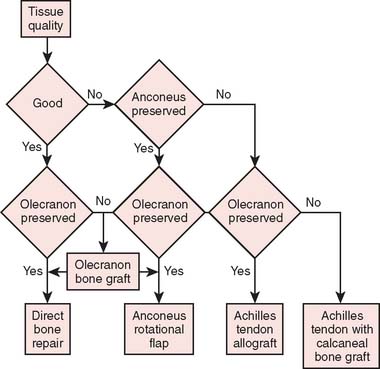CHAPTER 63 Triceps Insufficiency Following Total Elbow Arthroplasty
INTRODUCTION
Triceps insufficiency can occur as a result of traumatic rupture of the tendon or, most commonly, following a failed surgical reattachment, particularly when there is poor tendon quality.5,12,15,17,18 As a complication following elbow replacement, this is becoming much more appreciated.4
According to the limited literature available on this topic, the incidence of triceps insufficiency following total elbow arthroplasty ranges from 1% to 29%.7,9,10,14,16,17 A recent report using the Gschwend approach documents four of 28 elbows with triceps insufficiency after a triceps-splitting approach to insert the GSB implant (Center Pulse, Zurich).11 In a recent comprehensive review of the literature, Voloshin et al22 documented an incidence of approximately 1% to 5% of triceps insufficiency associated with total elbow arthroplasty. Typically, literature reviews understate the true incidence of this problem.
The key factor in avoiding the development of this problem is the nature and execution of the surgical exposure. In this regard, a number of recent studies23 have examined modifications to existing exposures (see Chapter 7).6,19 Olecranon osteotomy is contraindicated in joint replacement surgery. Hence, some means of dealing with the triceps attachment is necessary. There are several options:
PRESENTATION AND SYMPTOMS
All patients will report loss of active extension and about 15% to 20% will also report pain.4 The most common problem is the inability to reach above the head and to push through doors. The mean time from initial procedure to revision for triceps insufficiency is about 3 years. In our experience the clinical findings at the time of surgical revision were (1) a change in the posterior contour of the elbow with visual and palpable prominence of the implant and atrophy of the subcutaneous tissue; (2) the presence of an olecranon bursitis; (3) atrophy of the triceps muscle; and (4) discernable lateral subluxation or dislocation of the extensor mechanism.
MANAGEMENT
Our recommendations are based on the Mayo Clinic experience with triceps insufficiency for any cause21 and particularly after joint replacement.4 From 887 total elbow arthroplasty operations, we identified 16 elbows that underwent subsequent surgical treatment for triceps insufficiency at our institution. The underyling diagnoses for which the primary total elbow arthroplasty was performed were rheumatoid arthritis in nine cases and post-traumatic conditions in seven cases. Initially, the triceps-sparing approach as described by Bryan and Morrey2 was used in 15; in one patient, the triceps-splitting approach as described by Campbell3 was used.
REPAIR OR RECONSTRUCTION
The logic we currently employ to determine how these problems should be managed is similar to the algorithm developed for management of triceps insufficiency for any cause13,21 (Fig. 63-1). If the tissue quality is good and the olecranon is preserved, we repeat the direct attachment to bone if the tissue is of adequate quality for this. If the tissue is not of good quality but the anconeus and the olecranon are preserved, then we perform an anconeus rotational flap. Finally, if the tissue is not of good quality and the anconeus is not perserved, then an Achilles tendon allograft is carried out. The calcaneus is used to supplement the olecranon if it is resorbed; otherwise, the tendinous tissue is sewn to the intact olecranon and the calcaneus is removed from the allograft.








